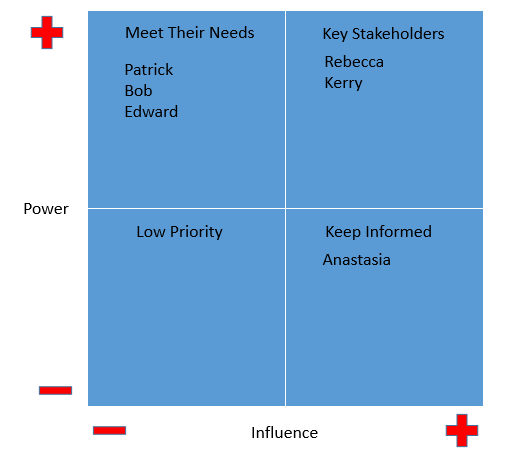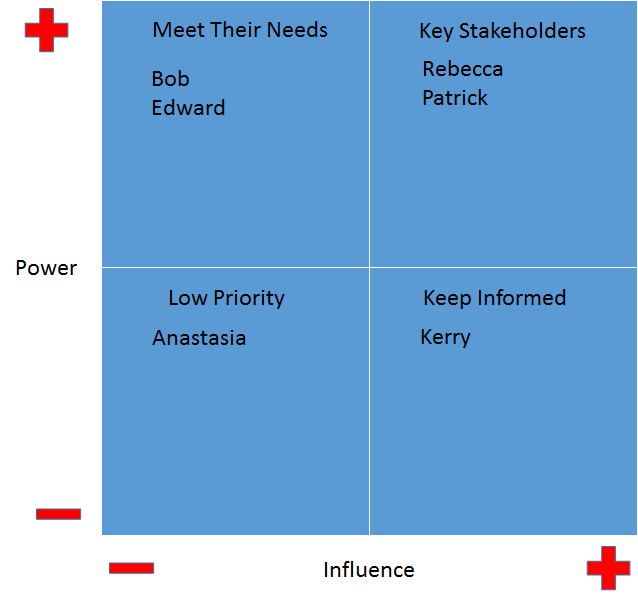Real-World Scenario: Agility
The following grids represent all stakeholders relevant to the case study under consideration, based on their power along with their interest in the project. Figure 1 illustrates the “perfect grid,” where all stakeholders are placed based on their supposed roles in the project (Thompson, 2018). Here, Rebecca and Kerry are key stakeholders as they are the ones completing the project. Anastasia, as a compliance officer, needs only to be informed of progress and is expected to intervene and give recommendations only when it appears that the software is non-compliant with ACME standards for EVM development.


Figure 2, in contrast, illustrates the actual power-interest grid for the project. As can be seen, several important changes happened as a result of various ethical and compliance dilemmas that arose throughout completing the project. For example, Anastasia was moved from the category of Keep Informed stakeholder to Low Priority stakeholder as her requests for reports were ignored, her feedback was not followed, and her ability to exercise any power over the project was significantly diminished. Kerry was removed from the category of Key Stakeholders, despite being one of two managers in charge of production. Her job was reduced to following Rebecca’s orders with no say in the matter, and key information was withheld from her as well. Patrick, on the other hand, was moved to the category of Key Stakeholders as he practically took control of the operation, and instead of just meeting his needs, Rebecca referred to him for questions that were outside his professional competence.
Compliance Issues
The main compliance issue in this project involved customer needs and ACME standards for EVM programming. Stakeholders involved in solving these issues were Rebecca, Kerry, Patrick, and Anastasia. From Patrick’s and Rebecca’s perspectives, it was more important to comply with customer demands than ACME’s standards. The issue with such an approach is that ACME standards are critical for ensuring accurate data reports. As evidenced in the case, non-compliance with these standards in favor of customer demands resulted in inaccurate data, threatening to ruin the purpose of the programming software (Kliem, 2011). Kerry and Anastasia, on the other hand, wanted to implement ACME standards, and for this reason, Rebecca removed Kerry from active participation in the decision-making process and kept Anastasia in the dark.
Ethical Issues
The ethical issues presented in this case study include the choice between complying with customer demands versus promoting an objectively better product, disrupting the project’s chain of command, lying and falsifying reports for the sake of project completion, and not reporting noncompliance for the sake of the project going smoothly.
These issues are all related to various stakeholders, but the majority are tied to Rebecca. From Rebecca’s perspective, avoiding conflict with the customer by following Patrick’s every word seemed a better decision than coming into conflict with him for the sake of providing more accurate data and ensuring ACME compliance. This decision was unethical because it prioritized the manager’s psychological stability over the customer’s need for a quality product. Although Patrick was the project’s government overseer, he did not understand the intricacies of creating EVM software. It was Rebecca’s duty to explain the consequences of not following ACME standards. Typically, the demands for the final product are not completely set in stone and can be revised (Kerzner & Kerzner, 2017).
Kerry’s ethical dilemma lay in choosing between following Rebecca’s orders—even though she perceived them as wrong—or trying to find an outlet to change the situation. While the initial decision to report to Anastasia was correct, considering the circumstances, Kerry did not return to the chain of command and started reporting to Anastasia instead of Rebecca, which caused a shift in power and a growing rift of distrust between the two key stakeholders, which eventually took Kerry out of the project (Kliem, 2011).
The issue of lying and falsifying report data by Rebecca brings up several considerations. At this point, the manager saw Anastasia as a hindrance rather than an asset and wanted to ensure that the project would be completed according to Patrick’s designs as well as hers. She falsified reports as a means of keeping the compliance manager unaware and preventing interruptions. This strategy was unethical because it put the goal of completing the project at odds to provide a quality product to the customer (Kliem, 2011). As a result, the product, while technically compliant with customer demands, generated historically inaccurate and therefore useless data.
Anastasia’s ethical issue lay in choosing between immediately reporting repeated transgressions on Rebecca’s part to her superiors or trying to work things out with Rebecca. Thus, the choice was between causing a scandal that would potentially halt project completion due to a sudden change in command and allowing improper behavior to continue. The ethical decision in this scenario was to report the transgressions and force Rebecca into compliance. While this course of action would potentially have stalled the project, it would have ensured accurate results and compliance with ACME standards. Noncompliance generated a faulty product needing corrections, thus causing a zero-sum result between these two approaches in terms of time and efficiency (Millage, 2012).
Several potential ethical dilemmas are also related to Patrick, but there is not enough data to pin them specifically to him. Bob and Edward played a minor role in this case study, meaning that no ethical decisions and dilemmas could be attached to them.
What Could Have Been Done Differently?
The main issues with the project came from the unstable relationship between Rebecca, Kerry, and Anastasia. In hindsight, each of them could have taken several steps to prevent the situation from escalating. Rebecca should have kept to the main rule of all software projects: Accuracy of data trumps any functionality demands made by the customer. Bottom line: The customer needs accurate data (Kliem, 2011). If data accuracy is sacrificed for comfort, then the entire software product becomes useless as its reports are inaccurate and cannot be relied upon (“Five keys,” n.d.). Rebecca, Kerry, and Patrick should have been key stakeholders, working together, and making collective decisions regarding program functionality. Rebecca should have made ethical decisions related to the various challenges she faced during the project. Reporting falsified data is unacceptable, as is eliminating team members from active decision-making based on personal preference. Anastasia should have exerted more force over the project to ensure compliance and prevent the situation from getting out of hand. However, her ability to do so was diminished by false reports. Kerry should have actively sought to remain a part of the project and not exempt herself from reporting to Rebecca over Anastasia.
Dealing with the Aftermath
The situation puts Rebecca, Kerry, and Anastasia in a difficult spot. Rebecca must take responsibility for her decisions, while Anastasia is required to oversee the corrections made to the software to ensure at least partial compliance with ACME; unfortunately, fully redoing the project would be impossible due to budgetary and time constraints (Katzman, 2014). Kerry’s role in the project has technically ended as she has been dismissed by Rebecca. To succeed, the three employees under discussion need to put their differences and past transgressions behind and start anew, deal with the issues at hand, and complete the project.
References
Five keys to reducing ethics and compliance risks. (n.d.). Web.
Katzman, R. (2014). Changing project managers midstream. Web.
Kerzner, H., & Kerzner H. R. (2017). Project management: A systems approach to planning, scheduling, and controlling. New York, NY: Wiley.
Kliem, R. L. (2011). Ethics and project management. Boca Raton, FL: CRC Press.
Millage, A. (2012). Ethics and the workplace. Internal Auditor, 2012, 7.
Thompson, R. (2018). Stakeholder analysis. Web.